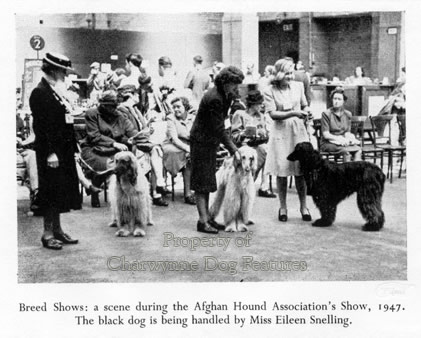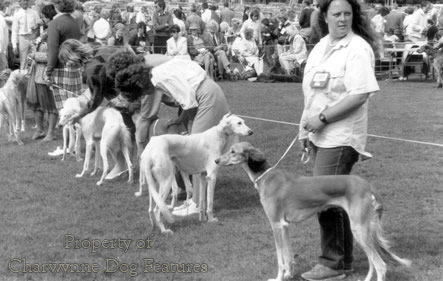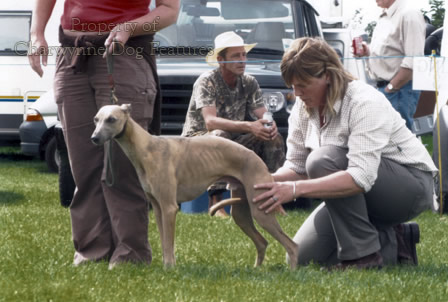407 JUDGING THE SIGHTHOUND
JUDGING THE SIGHTHOUND
by David Hancock
 Judging Criteria
Judging Criteria
“Among cattle and sheep-breeders it is generally admitted that certain leading qualities shall be considered all important, such as the propensity to carry flesh of good quality on the parts most valuable to the butcher, early maturity, and, in the sheep, quantity and quality of wool. But in horses and dogs, and more especially in the varieties of the latter, there is not the same unanimity, even in the leading principles; and in matters of detail, as may naturally be supposed, the difference of opinion is very great.” Those words, written by ‘Stonehenge’ in his Dogs of the British Islands of 1878, could be rephrased nowadays when so many dog breeds can be judged on their ‘wool’ and their ‘flesh’. Fortunately the sighthound breeds are spared this false appraisal, overweight exhibits being easily spotted and appropriately devalued, although the ‘wool’ on the Afghan Hound can be excessive.
Knowledge of Purpose
“To judge a breed by working-type standards involves a deep knowledge of its particular purpose in the canine world, be it to follow a line of scent and tenderly retrieve game, or to point and set the position of game unseen, or to face and set a fox or badger in his den, or to match the speed and nimbleness of a hare until it escapes from sight. Each of these functions requires and calls for special physical and mental faculties with which the appropriate breed is naturally endowed.” Those wise observations by H. Edwards Clarke in his book The Greyhound of fifty years ago, should be engraved on the thinking of not just sighthound judges but those who appoint them. Fitness for function may be a new Kennel Club cry but, in the world of the sporting dog, it has always been the ultimate judgement.
Lack of Experience
The sighthound breeds at dog shows are not always the best ‘showers’; most of them resent such immodest blatant exhibitionism, as they might see it, preferring activity and expecting to be judged on performance not pushiness. Judges who know such breeds usually acknowledge this, although many lurcher judges at country shows lack the experience to see past this group-reluctance to perform artificially. Assessing any breed of dog in a ring is always going to be a combination of judgement, ideally objective, knowledge, and a technique. Sadly far too many judges that I see appear to base their decisions on 'gut-feeling' or by taking a shine to a particular dog on the day, or concentrating on fad breed points. One sighthound judge at Crufts in 2010 reported: “When I first judged Salukis in 1966 one could see all the characteristics that govern Salukis. Now it is difficult to find the ruff, the long tails, the bright oval eye, the dignified gentle expression and the unique shaped foot.” Would such details matter to a Bedouin hunter? Only as an afterthought did this judge add: “Some movement leaves a lot to be desired.” Now that would bother the Bedouin hunter!
Need for Technique
A judge with knowledge is always going to triumph over one just hoping to get his decisions right. A judge with a technique is more likely than any other one to make sound decisions. Fanciers who pay money to enter a ring and travel a long way to get there deserve a competent judge. But time and time again, especially at lurcher and terrier shows, I watch judges at work in the ring, who apply a different sequence to each exhibit, only check one aspect of movement and fail even to examine some parts of the dogs' anatomy. I don't believe that their judgements are subsequently soundly based. In any field of human activity knowledge applied through a tried and tested technique will surpass 'gut-instinct' every time. Assessing quality by eye alone is far better when the visual image conveyed is tested by a hands-on examination. In this regard, I believe that the Kennel Club show ring routine of a systematic close-up physical check is potentially far more accurate than say a houndshow judge viewing packhounds at Peterborough, Honiton or Rydal solely from a few yards away, with no closer ‘hands-on’ examination.
Need for Ringcraft
Far too many exhibitors at country shows expect the judge to see merit in their entry when they themselves have done little to prepare the exhibit for the ring. Some terriers and many gundogs are natural show-offs, most sighthounds are not. Dogs need to be schooled for the ring - not slavishly prepared, but trained to walk briskly on the lead and stand still during closer scrutiny. A future judge's examination of the bite is made easier by previous rehearsal. Why should your dog unquestioningly allow a complete stranger to look inside its mouth? But jaw construction really does matter and a competent judge will always want to check this important feature of a sporting dog. The judge can better apply his judging technique if the exhibitor's ring technique has been practised and the exhibit rehearsed. This can significantly affect placings. Why exhibit a really good dog but make no attempt to school it in the requirements of the ring? Why not help it win?
Identifying Breeding Material
The most valuable purpose for me in showing dogs in any ring is to identify future breeding material. The most important factor for me is: could this dog carry out its breed function? We all like a handsome dog but handsome unsound dogs, sadly, do win. I attended the 2003 World Dog Show in Dortmund and spent several days at the show. I have never seen so many unsound dogs under one roof in my entire life; some of them won prizes! Sportsmen expect their dogs to function. This capability is so much more important than beauty or breed type, the latter originating in function, but is so regularly betrayed by human whim. Hounds of all types, sighthounds especially, must never be judged on cosmetic appeal but on their anatomy's ability to carry through their function. Those breeding for flashy markings beware! The best show ring judges make their decisions on soundness and conformation to the breed standard, not showmanship.
Overall Soundness
Fault judging is no help to anyone, breeder, owner, the status of the show, the sport of showing itself. Overseas they often list faults according to their seriousness, i.e. from disqualifying ones down to merely undesirable ones. No sighthound should ever win in the ring if it features incorrectly-sloping shoulders, short upper arms, a weak neck or loins, poor feet, a short body (especially with a long back) or shoulder blades which touch when the dog stoops to put its nose to the ground. There is no such thing as the perfect dog; it's vital to judge the whole dog, not descending on the animal, oozing praise just because it's in superlative condition, has powerful hindquarters or a superb head. The sporting dog needs every part of its body to be sound! In KC show rings far too many breeds are judged solely on their heads or their coats or their flashy gait. Far too many judges ignore poor condition in the entry before them. This, when sporting breeds are on parade, is an insult to the heritage of these breeds.
Learning from the Past
It often pays to look at portrayals of the top dogs of the past to establish in your mind’s eye what the dog before you in the ring should resemble. In his Dogs and I, Hutchinson, 1928, the show judge and coursing Greyhound expert, Harding Cox, used an illustration of Champion Okeford Queen to show what he considered ‘a perfect specimen of the show Greyhound’. In early Edwardian times, the Deerhound Champion St Ronan’s Rhyme, born 1903, bred by the great Deerhound breeder Harry Rawson, was described as ‘probably the most perfect dog of any breed living in her time’. Both dogs had wonderful symmetry, a hint of athletic power and no sign of the slightest exaggeration. Neither of these quite outstanding dogs was shown with its hindfeet in the next county! The famous Saluki Champion Sarona Kelb and the two exceptional coursing Greyhounds Master McGrath and Fullerton also showed these qualities. But being able to spot faults is clearly not within every show judge’s range of skills – the placings by some being strangely faulty in themselves. In her perceptive book The Book of the Greyhound, TFH Publications Inc., 1999, Sue LeMieux sets out the ‘Faults in a Greyhound’ both succinctly and with clarity. It is worth comparing her illustration, with its eighteen key points, with the depictions of the great sighthounds listed above.
Hunting Requirements
Judges must start by accepting the fundamental fact that a hound that hunts using its speed must have the physique to do so. Immense keenness for work will always come first but the build to exploit that mental asset comes close second. A sighthound judge must look for, at the front, a long strong muzzle with powerful jaws and a level bite. How else can the hound catch and retrieve its quarry? The nose should be good-sized with well-opened nostrils, for, despite some old-fashioned theories, sighthounds hunt using scent as well as sight. A long muzzle permits better scenting. For any sighthound to succeed, its eyes should be fairly prominent and be set slightly oblique, to the side of the head. One eye should look away to the right and one to the left so that, like any good rangefinder, both eyes can be used for long distance marking. It is likely however that at close range only one eye is used at a time. The neck should be long but symmetrically so, muscular and firm. Length of neck does not improve 'pick up'; flexibility in the 'swoop' comes from the placement of the shoulder blades. Good judges look out for such points.
Sighthound Anatomy
A sighthound must have powerfully-set shoulders; I always apply the 'two fingers width' test to the space between the shoulder blades of a stooping dog. Many show Great Danes have to spread their feet to drink from a bowl of water on the ground because of excessive narrowness in the set of their shoulder blades. The sighthound's back should hint at suppleness and power, be slightly arched in the lumbar region, yet have a mainly level topline. The chest should be deep from the withers to point of elbow but be fairly flat, with the underpart of the brisket fairly broad across. The ribs should be well separated, with good lung room and space between the last rib and the hindquarters to allow a full stride. At full stretch, the impress of a hare's hindfeet is implanted in front of that of the forefeet; the sighthound should have the same capability. There must also be freedom of suspension in the ribcage or thorax in the way it is 'cradled' by the scapulae - the dog needs to utilise this when hurdling a farm-gate or turning at high speed. What a sighthound is expected to do must constantly be in the judge’s mind.
Balance Essential
Inequality between the length of the rear stride and the length of the front stride is producing ugly unsound movement in an ever increasing number of breeds as the contemporary fad for hyper-angulation in the hindquarters gathers more and more momentum. In far too many sporting breeds the hind feet have difficulty keeping tally with the front ones. This, combined with inflexibility in the spine, produces a failure of synchronisation behind. In soundly constructed dogs sufficient angulation in the hindquarters and adequate length in the tibia enables the hock to flex and the hind foot to advance beneath the body enough so that balance is maintained. The side effects of excessive angulation in the hindquarters of a number of pedigree breeds are increasingly manifesting themselves. Why then is it becoming almost 'de rigueur' in breeds like the show Greyhound, the Great Dane - a running mastiff, and the show Whippet? Top judges always look for a balanced hound; exaggeration in sighthounds hinders great pace and that’s never good for the dog.
Handicapped Movement
In every animal walking on four legs the force derived from pressing the hind foot into the ground has to be transmitted to the pelvis at the acetabulum, and onwards to the spine by way of the sacrum. In over-angulated dogs the locomotive power is directed to an inappropriate part of the acetabulum. In addition, so as to retain the required degree of rigidity of the joint between the tibia and the femur, other muscles have to come into use. In the over-angulated hind limb, the tibia meets the bottom end of the femur at such an angle that direct drive cannot ensue. The femur can only transmit the drive to the acetabulum after the rectus femoris muscle has contracted, enabling the femur to assume a degree of joint rigidity when connecting with the tibia. This means that the femur rotates anticlockwise whereas nature intended it to move clockwise. The knowledgeable judge will know of this; novice judges need to learn of it. Judges' decisions influence breeding plans - breeding plans decide the future breed!
Locomotive Disaster
Excessive angulation in the hindquarters, with an elongated tibia, may, to some, give a more pleasing outline to the exhibit when 'stacked' in the ring. But, in the long term, it can only lead to anatomical and locomotive disaster. Such angulation destroys the ability of the dog's forelimbs and hindlimbs to cooperate in harmony in propelling the body. Yet I have heard it argued by breed specialists at seminars that it will increase the power of propulsion operating through the hindlimbs and on through the spine. If it did, the racing Greyhound fraternity would have pursued it with great vigour. I have heard a dog show judge praise an over-angulated dog because it 'stood over a lot of ground'! So does a stretch limousine – but it’s designed to do so! It is worth comparing top class show Greyhounds from the Shalfleet kennel, such as Stop That Tiger, Sir Lancelot and Stop The World with portrayals of great dogs from further back: Tom Sharples’s Lauderdale, a very successful show dog in the period 1873-1880 and the superb coursing Greyhound bitch Age of Gold of around that time. The proportions in each of these dogs are roughly the same; the balanced anatomy is there. Sighthound judging requires knowledge!
Sound Angulation
The hindquarters must be powerfully constructed if they are to propel the dog forward in the chase, but symmetry and balance fore and aft are the key to turning ability. Every sighthound depends upfront on good long arms and forearms, and, in the hindlegs wide and muscular thighs and second thighs, length of stifle and sound angulation. Many of the early breed standards were based on the knowledge of those better acquainted with horses. The expression ‘hocks well let down’ refers to the heel bone itself, i.e. the point of hock and not to the rear pastern as a whole. It means a short heel bone not the distance between the foot and the heel. The feet should be compact with well-knuckled toes and short claws, naturally worn from working or sound exercise. Some old-school Greyhound experts used to assess a dog by looking at the tail first, noting any sign of coarseness, desiring the tail of a rat in appearance, long and whip-like with little hair. I suspect that some of them were checking on alien blood rather than signs of excellence.